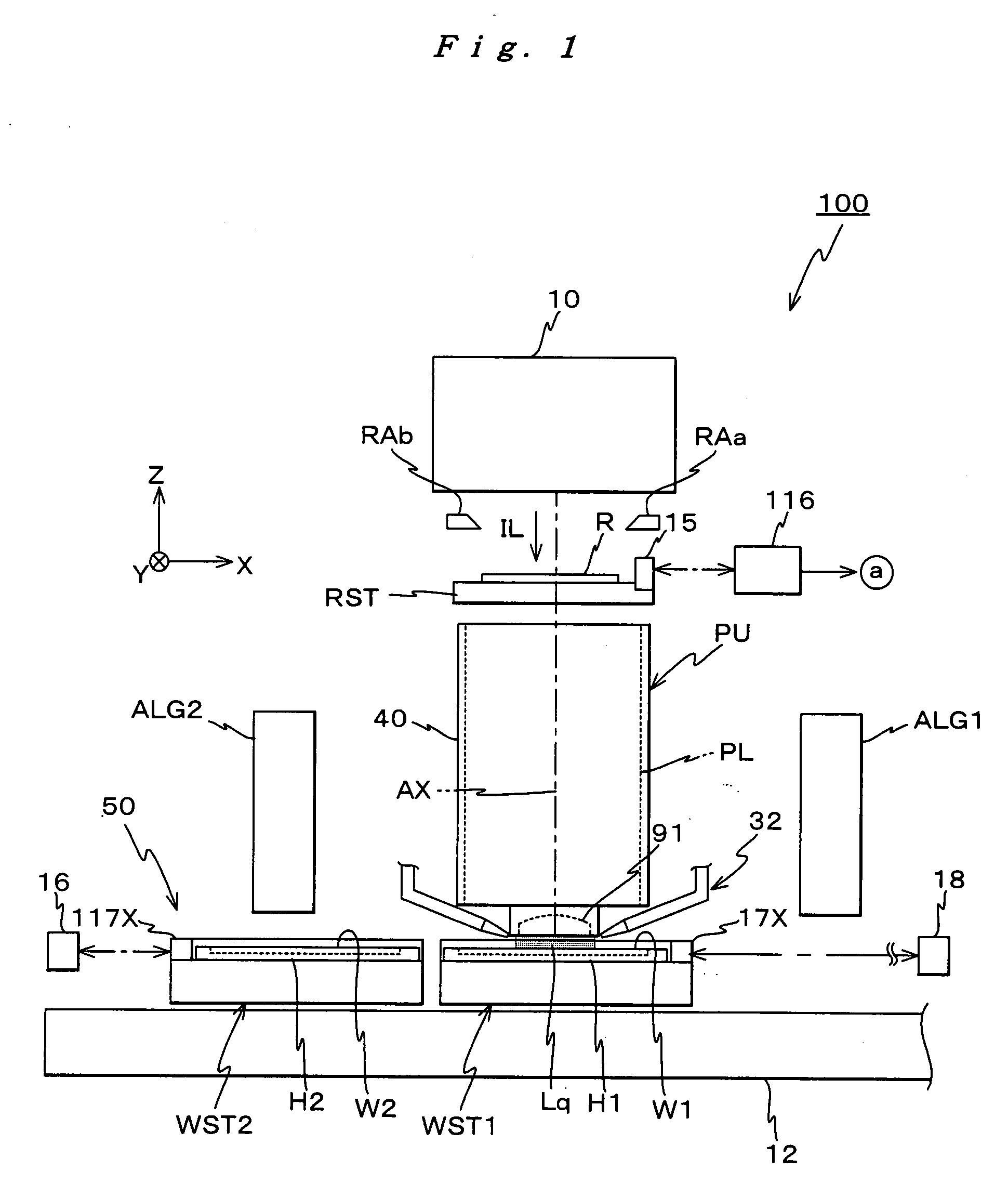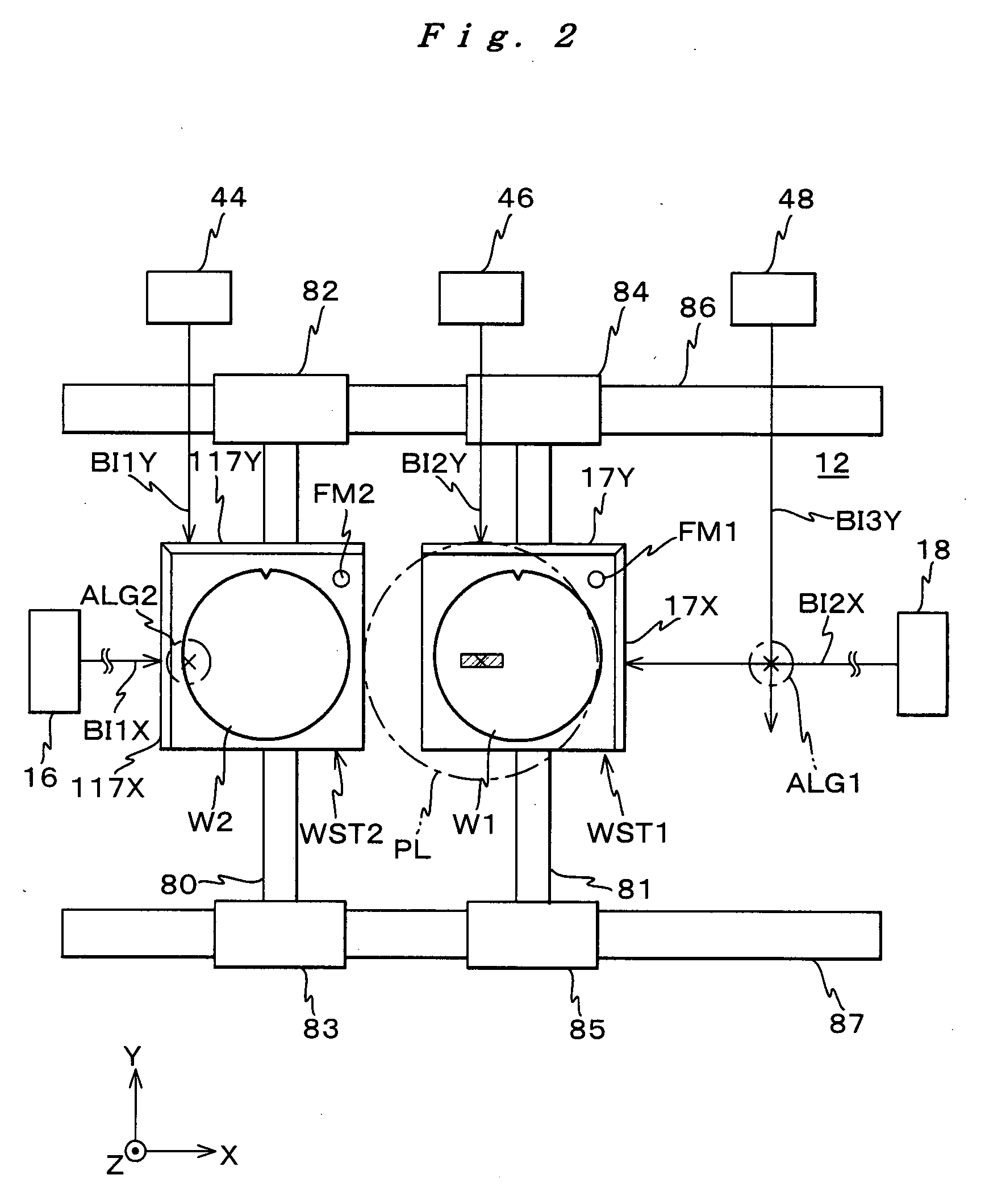Stage drive method and stage unit, exposure apparatus, and device manufacturing method
a technology of stage drive and exposure apparatus, which is applied in the direction of photomechanical equipment, instruments, printing, etc., can solve the problems of affecting the quality of the exposure operation, the depth of focus may become so small, and the focus margin shortage may occur during the exposure operation, so as to prevent or improve the throughput, and suppress the leakage of liquid
- Summary
- Abstract
- Description
- Claims
- Application Information
AI Technical Summary
Benefits of technology
Problems solved by technology
Method used
Image
Examples
first embodiment
A First Embodiment
[0069] A first embodiment of the present invention will be described below, referring to FIGS. 1 to 10.
[0070]FIG. 1 schematically shows the entire configuration of an exposure apparatus 100 related to the first embodiment. Exposure apparatus 100 is a projection exposure apparatus by the step-and-scan method, that is, the so-called scanning stepper (also called a scanner). Exposure apparatus 100 is equipped with illumination system 10, a reticle stage RST that holds a reticle R serving as a mask, a projection unit PU, a wafer stage unit 50 that has wafer stages WST1 and WST2, off-axis alignment systems ALG1 and ALG2, a control system for these components or assemblies, and the like. On wafer stages WST1 and WST2, substrates serving as wafers are to be mounted. In FIG. 1, a wafer W1 is mounted on wafer stage WST1, and a wafer W2 is mounted on wafer stage WST2.
[0071] As is disclosed in, for example, Kokai (Japanese Unexamined Patent Application Publication) No. 2001...
second embodiment
A Second Embodiment
[0174] Next, a second embodiment of the present invention will be described, referring to FIGS. 11 to 15B. For parts that have the same or similar arrangement as the first embodiment previously described, the same reference numerals will be used, and the description thereabout will be brief, or entirely omitted. In the exposure apparatus of the second embodiment, the configuration or the like of the wafer stage unit and the parallel processing operation using the two wafer stages differ from the first embodiment previously described. Further, the point where only one mark detection system is arranged is also different from the first embodiment previously described. The configuration or the like of other components or assemblies are similar to the first embodiment previously described. Accordingly, from the viewpoint of avoiding repetition in the following description, the differences will mainly be described.
[0175]FIG. 11 shows an arrangement of a control system ...
third embodiment
A Third Embodiment
[0231] Next, a third embodiment of the present invention will be described, referring to FIGS. 16 to 18B. For components or assemblies that have the same or similar arrangement as the first embodiment previously described, the same reference numerals will be used, and the description thereabout will be brief, or entirely omitted. In the exposure apparatus of the third embodiment, only the configuration or the like of the wafer stage unit differ from the first embodiment previously described, and the configuration or the like of other components are similar to the first embodiment previously described. Accordingly, from the viewpoint of avoiding repetition in the following description, the differences will mainly be described.
[0232] Different from wafer stage unit 50 that constitutes the exposure apparatus of the first embodiment previously described, as is shown in FIG. 16, a wafer stage unit 50″ of the third embodiment is equipped with a wafer stage WST on which ...
PUM
| Property | Measurement | Unit |
|---|---|---|
| wavelength | aaaaa | aaaaa |
| wavelength | aaaaa | aaaaa |
| refractive index | aaaaa | aaaaa |
Abstract
Description
Claims
Application Information
 Login to View More
Login to View More - R&D
- Intellectual Property
- Life Sciences
- Materials
- Tech Scout
- Unparalleled Data Quality
- Higher Quality Content
- 60% Fewer Hallucinations
Browse by: Latest US Patents, China's latest patents, Technical Efficacy Thesaurus, Application Domain, Technology Topic, Popular Technical Reports.
© 2025 PatSnap. All rights reserved.Legal|Privacy policy|Modern Slavery Act Transparency Statement|Sitemap|About US| Contact US: help@patsnap.com



